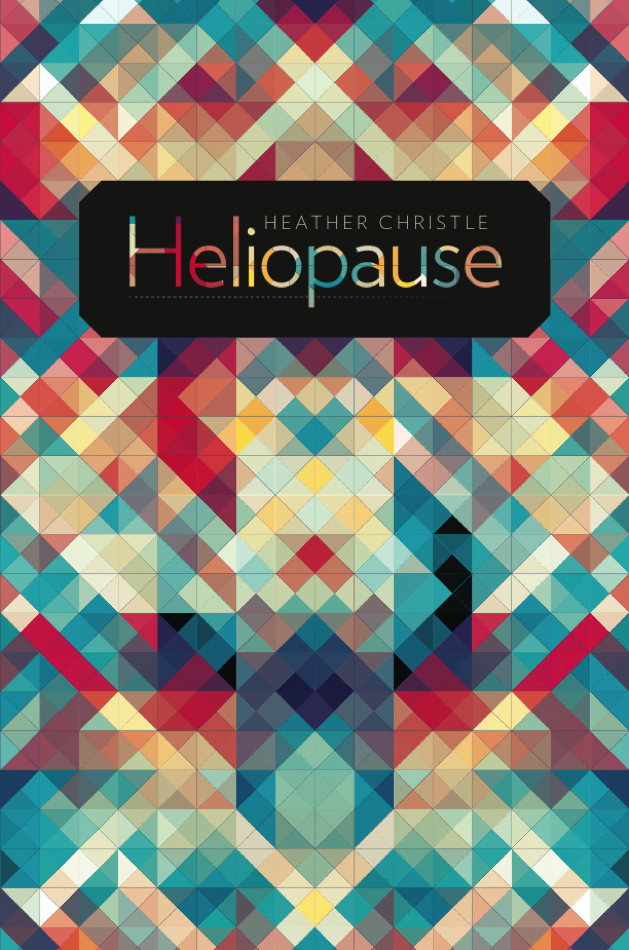
Heliopause by Heather Christle
a review by Jessica Rae Bergamino
Wesleyan University Press
2015
$24.95
Heather Christle’s fourth book, Heliopause utilizes the same syntactical playfulness and inventiveness as her previous volumes while asserting itself as a singular commentary on contemporary grief. Named for the theoretical boundary of our solar system, Heliopause is a richly wrought meditation on the emotional and temporal boundaries that separate us from ourselves and from each other.
The book is organized as nine sections, many of which are composed of single, long poems. We might think of nine planets reaching out towards the expanses of the universe (or, if you are post Pluto, eight planets and a sun). The first planet/sun/poem in the volume, “Disintegration Loop 1.1,” is an ekphrastic response to a film by William Basinski, which depicts lower Manhattan during the last hour of daylight on September 11, 2001. The poem meanders along the boundaries of poetic form, gesturing towards lyric as discreetly as it gestures inside fragment. Composed of short stanzas, couplets, and single lines separated by ornaments along the page, the velocity of accumulation means these moments resist the diminishment to aphorism, creating, instead, tender meditations on the grief inherent to not a changing world but a changing relationship to the world. “Every morning,” Christle writes, “the diminishing returns.”
Although we often speak of the poem teaching the reader how to read it, I’ve rarely seen that as discreetly or methodically enacted as in this poem. We are told
to what the person has to say
what the person had to say
and having the new words affirmed
you wait and listen again
How, then, to read a poem on loop? To understand the moments the poem presents as folding back upon one another, layering on one another, being said and having been said in the same breath? The temporal markings of the lyric become secondary to the possibilities of simultaneity, meaning the material boundary of the poem is transgressed by the poem itself. The National Center for PTSD recognizes flashbacks and sensations of reliving traumatic events as symptoms of PTSD; we might consider the poem that loops, that refuses the temporality required of the lyric, to be a poem of post-trauma. That said, “Disintegration Loop 1.1” certainly cannot be characterized as a “September 11th poem” – the focus of the ekphrastic is not the event itself, but, rather, how the event has already been metabolized in and through art.
As a reader, I best understood this mechanism of simultaneity when faced with two of the many literary references that occur throughout this poem and volume:
a long way
▲
They say the bomb is a flower
Here, Plath and Williams’ lines are shifted from singular speakers out into a collective mouth, implicating both the poets and the poetry readers in the juxtaposition between simultaneity and sincerity. Something is said, something is repeated, and, eventually, something is believed to be. “Realistic Flowers” continues to animate this process, depicting fake flowers bought at the dollar store as being planted
I was so happy I could have
torn your head apart
What else can you do? Aren’t the fake flowers real flowers, in their own way? Susan Stewart, in her tremendous On Longing, worries that poetic “language detached from its history, from the contradictions arising from its experience in real speech situations, would be empty, would be barren.” Christle proves herself, again and again, to be a master of troubling this distinction, this boundary. Her innovative use of daily speech at the crisis of lyricism moves through problems or questions of utility and into a reminder of the ways the daily acts of living and feeling are the very stuff that poems and poetic speech aspires to replicate.
“Elegy for Neil Armstrong” is an erasure of a transcript between Armstrong, Buzz Aldrin, and Mission Control during their moon landing. Presented as white text on black pages, the poem operates across a field of darkness, exploring not what is in the dark, but, rather, what is in the light.
As the poem erases towards O’Hara’s famous poem, the echo begs an important question: what is fame? What is spectacle? What happens to the spectacle body? In the same way that Plath and Williams exist in the mouths of the chorus, O’Hara exists in the very fabric of the poem, waiting to erupt through. By placing the production and repetition of the spacewalk in juxtaposition with the reproduction and repetition of September 11th in “Disintegration Loop 1.1,” Christle complicates the very nature of elegy. If the dead insist on returning in the mouths of strangers, how are we ever to grieve? If the flowers we leave on their graves are plastic, how will we return to tend to our dead? I admire the ways this volume opens up to these questions but refuses to answer them, acknowledging, instead, that
shadow now
everything
is sufficiently bright,
It is always the looking outward which makes a space for survival, for being okay. This is a discreet type of futurism, rooted in grief, in the darkness. This is testament to the ways we owe it ourselves to be as tender as we are fierce, as transparent as we are muscles and mystery. We live in the middle of it all, looking out for meaning at the same time that our lives are more mythic than we can handle. As Christle writes in “How Long is the Heliopause:”
and in this moment all the lights
go off at once and it is a bomb
or it is a daughter
What a luxury to be both. How exciting. How terrifying. Christle’s “It’s an Empire Out There” explores the political implications at stake in this dialectic, in this dialogue between lyricism and daily life, between the future and the destruction. The speaker incants
Whatever feeds us
In an interview with Cynthia Hogue, published in The Cracks Between What We are and What We Are Supposed to Be, Harryette Mullen says that “who I am is a political question, but who I can be is a question that literature can help me to answer.” Imagining a future, coming out of shadow into clarity, requires a type of radical visioning and re-visioning. It is an empire out there, yes, but it is an empire in here as well. Christle’s Heliopause proposes we can be more than the total of our distances, that our mourning can be a map towards our reemergence.
 Jessica Rae Bergamino is the author of the chapbooks The Mermaid Singing (dancing girl press), Blue in All Things: a Ghost Story (dancing girl press), and The Desiring Object or Voyager Two Explains to the Gathering of Stars How She Came to Glow Among Them (Sundress Publications, 2015). Individual poems have most recently appeared or are forthcoming in Gulf Coast, West Branch, Crab Orchard Review, Slice, and elsewhere.
Jessica Rae Bergamino is the author of the chapbooks The Mermaid Singing (dancing girl press), Blue in All Things: a Ghost Story (dancing girl press), and The Desiring Object or Voyager Two Explains to the Gathering of Stars How She Came to Glow Among Them (Sundress Publications, 2015). Individual poems have most recently appeared or are forthcoming in Gulf Coast, West Branch, Crab Orchard Review, Slice, and elsewhere.